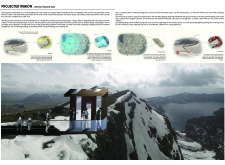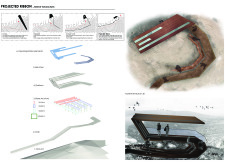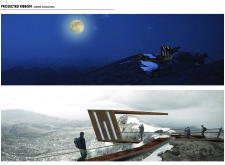5 key facts about this project
At its core, the project embodies a commitment to sustainability and innovation. The choice of materials plays a significant role in achieving these objectives. The building features a mix of concrete, timber, and glass, carefully selected not only for their aesthetic appeal but also for their performance characteristics. The concrete provides durability and thermal mass, while timber adds warmth and aligns with the natural environment. Glass is utilized to maximize natural light, creating an inviting atmosphere and visually connecting the interior spaces with the exterior landscape.
The design showcases a series of interconnected areas that encourage fluid movement throughout the space. The layout intelligently addresses functionality, providing designated zones for various activities while maintaining an open and welcoming environment. This strategic organization promotes interaction among users, enhancing the project's role as a community center. Elements such as flexible meeting rooms, collaborative spaces, and recreational facilities are thoughtfully integrated, allowing the building to adapt to the evolving needs of its users.
One of the unique design approaches taken in this project is the incorporation of green roofs and living walls. These features not only contribute to the aesthetics of the building but also serve ecological purposes, improving air quality and promoting biodiversity. By harnessing natural systems, the design encourages users to engage with their environment actively. Additionally, these elements help to mitigate the urban heat island effect, demonstrating a responsible approach to architecture in densely populated areas.
Natural ventilation has been prioritized in the architectural design, reducing reliance on artificial cooling systems. Large operable windows and strategically placed vents facilitate airflow, creating comfortable indoor climates year-round. This attention to climatic responsiveness reflects a holistic approach to architecture, emphasizing the importance of energy efficiency and occupant comfort.
The project's façade is both modern and contextual, featuring a rhythmic pattern that draws inspiration from the surrounding architecture. This thoughtful design detail fosters a sense of continuity with neighboring structures while establishing a distinct identity for the building itself. The carefully proportioned openings provide visual interest and allow for dynamic play of light and shadow throughout the day, enhancing the building's character.
Landscaping also plays a crucial role in the overall design, establishing a seamless transition between the building and its surroundings. Indigenous plants have been selected to create an eco-friendly environment that requires minimal maintenance while supporting local wildlife. Outdoor gathering spaces are integrated into the landscape, reinforcing the building's function as a communal hub and encouraging social interaction among users.
Attention to detail is evident in all aspects of the design. Finishes are chosen for both functionality and aesthetic value, with surfaces that are durable yet pleasing to the eye. The interiors exhibit a balance of simplicity and elegance, fostering an environment conducive to creativity and collaboration. Signage and wayfinding elements are intuitively designed to guide users through the space, enhancing usability without detracting from the overall design.
Ultimately, this architectural project stands as a testament to the possibilities of thoughtful design. It demonstrates an unwavering commitment to community values, environmental responsibility, and aesthetic integrity. Readers interested in delving deeper into the specifics of this project are encouraged to explore the architectural plans, sections, and other design elements to appreciate the nuances and innovations that define this remarkable undertaking.


























